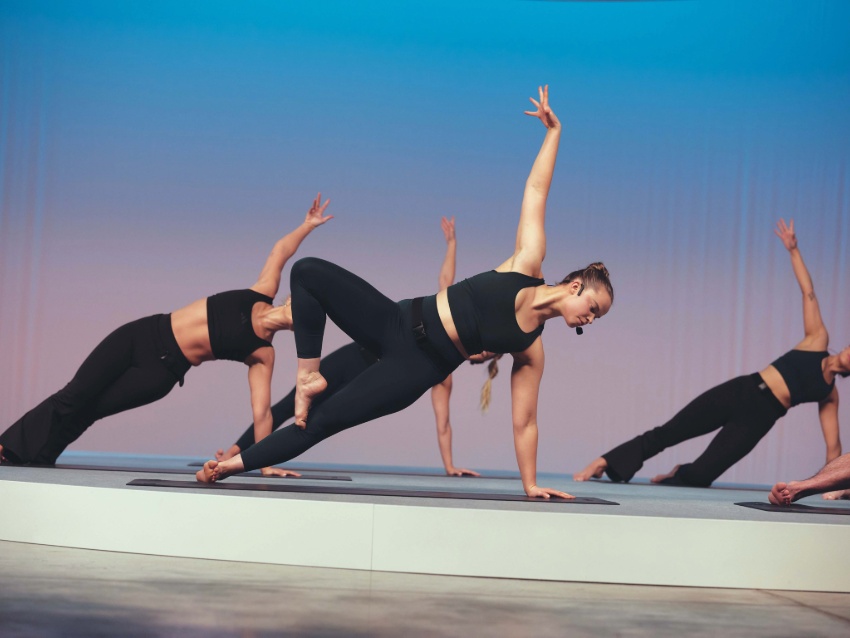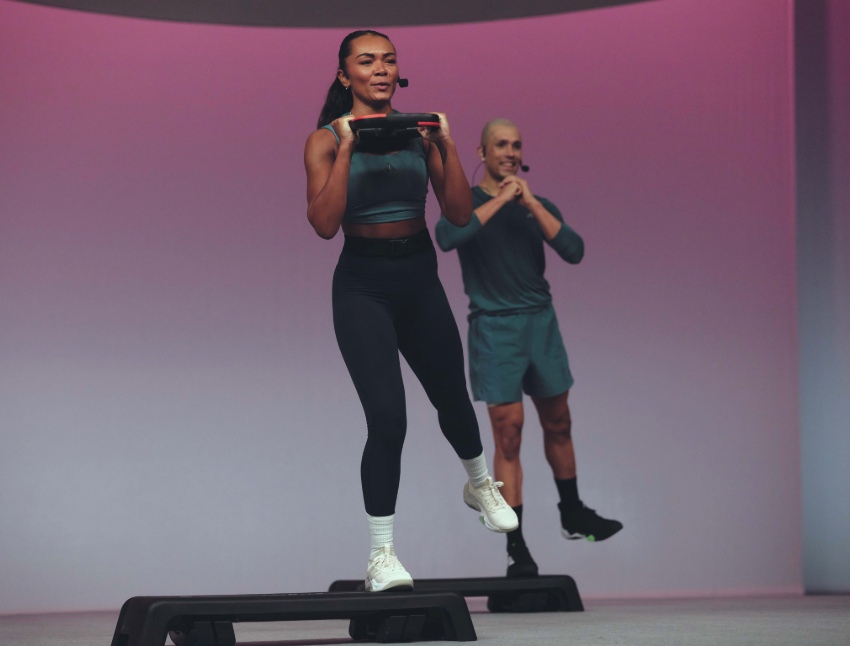
1. JOMO – The Joy of Missing Out
Forget FOMO (fear of missing out), 2026 is going to be all about JOMO – the joy of missing out. A welcome antidote to FOMO, JOMO involves being present and finding joy in one's current activities, prioritizing self-care, and being intentional with one's time, rather than feeling anxiety about what others are doing.
The mental health movement taught us that it’s ok not to be ok, while the rise of JOMO suggests it’s also ok to skip leg day every once in a while. And there’s a growing emphasis among fitness providers and patrons that rest and recovery are equally important for sustainable progress.
Multiple studies have shown that the ‘no pain, no gain’ ethos of gyms gone by can be a turn-off for younger generations and fuel feelings of ‘gymtimidation’, prompting operators to take a gentler stance to win long-term loyalty.
UAE-based operator GymNation won widespread plaudits for removing all of the weights from its gym floor on World Mental Health Day, replacing them with a note saying: “The only weight we want people to lift on the 10 October is the weight off their mind.”
Meanwhile, Zone Zero training is gaining traction with its emphasis on ultra-low-intensity movement – appealing both to gym newbies taking their first tentative steps and grizzled veterans seeking something gentler to offset their more strenuous workouts.

2. Crossing the wellness chasm
It may seem counterintuitive for gyms to encourage members not to work out from time to time, but a JOMO stance could hold the key to unlocking even greater growth. Where once clubs were considered just a spoke in a consumer’s wellness wheel, they’re increasingly being seen as the main component.
In a world where consumers are drowning in data and feeling anxious from obsessively tracking their health metrics, clubs are helping members become smarter and savvier – with a clear idea of what they need and want. Soon-to-be-released research shows gym members are nearly twice as likely to have a strong understanding of how to improve their wellness, while two-thirds of members say the gym is one of, if not the most important element of their wellness toolkit.
By expanding their Mind/Body offerings (with enhanced yoga timetables, breathwork and meditation sessions) and adding wellness-themed digital content and health service bolt-ons to memberships, gyms around the world are starting to position themselves as a one-stop shop for wellness needs, with premium operators like Equinox and Third Space leading the charge.
Wellness expert Anna Bjurstam, Senior Strategic Advisor at Six Senses Hotels Resorts Spas, believes clubs have a golden opportunity for growth if they can clearly demonstrate their ability to meet broader needs.
“Fitness is great, but the industry needs to broaden its scope and embrace wider wellness to keep moving forward,” she told operators at the recent HCM Summit in London.
“Today’s consumers demand integrated wellbeing solutions combining diagnostics, science, health and fitness to support longevity. I believe longevity will be the next frontier for health clubs. This could cover healthspan optimisation, mobility, mitochondrial health, rest and recovery, biomarker integration, digital twinning and more.
“It sounds complex, and you could spend a fortune on fancy tech and machinery to support this, but right now the most important thing is to invest in staff training and education so they’re equipped to help members make sense of their wellness requirements.”
3. Connection takes center stage
Sometimes the most obvious truths are the ones we need reminding of. And right now in fitness, everyone’s reiterating the importance of connection. Connection to your gym, your Instructors and your fellow participants.
The latest ABC Fitness report found 73% of club members say community plays a crucial role in fitness motivation and consistency, noting that “members join for health, but stay for connection”, or as Phillip Mills would put it: “No one ever left a gym because they had too many friends there.”
Modern consumers – particularly Gen Z – are experiencing unprecedented levels of isolation and loneliness. As a society, we spend 70% less time with our friends than we did a decade ago, driving a desperate need for in-person connection and community.
With demand for live fitness experiences at an all-time high, clubs have a huge opportunity to turbocharge growth by leaning on the most engaging elements of the club.
The rise of gym-based run clubs and HYROX – alongside recent case studies from leading operators like EOS and West Wood Clubs – pay testament to the power of a community-driven club strategy. Meanwhile, Sondre Gravir, CEO of SATS, has hailed the Nordic chain’s group exercise strategy for driving recent revenue uplift, revealing that SATS members who do classes stay 1.8 times longer than others (Fitness News Europe, November 2025).

4. Strength in depth
Demand for strength shows no sign of slowing, but consumers are becoming more discerning about their strength training – and clubs are expanding their offerings in response.
Beyond pumping iron on the gym floor, options to boost overall strength such as yoga, Pilates and circuits are all gaining in popularity. And with strength training a key modality for all ages – not just Gen Z, but those experiencing perimenopause/menopause, older adults and those taking weight-loss medication – expect to see many more shades of strength showing up in training programs throughout 2026.
Gyms across the world have been swapping out cardio equipment for extra weight stations on the gym floor, while a raft of new strength-based classes have quickly come to prominence – particularly as a means of alleviating lengthy queues at the squat racks.
To this end, Les Mills recently launched BODYPUMP HEAVY™ – an addictive new program designed to make safe and effective weightlifting accessible for everyone by removing common ‘gymtimidation’ barriers and dialling up the workout experience with iconic music, group energy and an expert Les Mills-certified Instructor.
Backed by the science of BODYPUMP™ – the world’s most-loved strength class for over 30 years – BODYPUMP HEAVY has been crafted so operators can service growing strength demand through their studios, boosting overall club capacity and building community to drive retention and member referrals.

5. Digital twins
The concept of digital twinning isn’t entirely new: it was first deployed by NASA in the 1960s, using simulators to model the impact modifications would have on the performance of Apollo spacecraft. More recently, it’s become prominent in manufacturing, but now, advances in body tracking and AI mean digital twinning is gaining traction as a way of improving our health.
These digital twins are virtual replicas of an individual, created using body metrics from wearables, lab results and meal logs. They work by continuously monitoring physiological data like heart rate and glucose, analyzing it to simulate performance, and then providing real-time, data-driven recommendations for training, nutrition, and recovery.
Twin Health offers hyper-personalized AI digital twin care plans to its users and the healthtech company recently announced a content partnership with Peloton to provide personalizsed workout recommendations based on its users’ training goals.
The concept is also being applied to gym management, with the Gym Twin platform from TwinLabs helping operators create a 3D digital version of their facility with real-time tracking, using the data to inform decisions around floorplan, timetabling, equipment, staffing and more.
As the concept gathers steam, expect to see operators (most-likely premium at first, working with third-party partners) offering members the ability to create their own digital twins.
6. The space race
The rise of digital twins is just one of many examples where the fitness industry is moving past the age of gut feels and embracing the abundance of data to settle debates and inform decisive action.
Squeezed margins and high operating costs are forcing operators to think outside the box to get more from their facilities and maximize capacity. One example is Fitness & Lifestyle Group, which used footfall insights to remove creches from its clubs and unlock 30,000 sq m of gym space. The leading Australian operator is also breathing new life into its group training studios by creating “Performance Zones” featuring black walls, industrial-style lighting, and open training spaces, designed to demystify the studio and encourage members to use the spaces for their own training when classes aren’t taking place. Meanwhile, many other operators are adding extra classes on the gym floor to attract new participants, build a buzz and boost Contribution Margin by servicing more members per square meter.
“The most expensive overhead of any club is the bricks and mortar itself. So you've got to ask, how do I maximize the return from every square meter or square foot?” notes experienced club operator and fitness economist Gerry Salmon.
“When you look at the layout of a club, you have to ask how much you are dedicating to an exercise space, and how much income that space will generate. Once you've done that, you look inside those exercise spaces and consider how they’re divided up, in order to create the greatest contribution to the club.”
Contribution Margin (the return a club gets from each area based on Capacity X Utility X Flow Rate) was one of the key themes from the recent report ‘MVPs: The New Power Players in Club Growth’. It found prioritising floor space for activities with the highest Contribution Margin and filling them with the most profitable types of members enables clubs to maximize capacity and revenue potential. The report pinpointed MVPs (Most Valuable Participants) as the members to target, because they attend their club more often, stay longer, and have a higher lifetime value (LTV) than any other member category. Check out this free ROI Calculator to see what attracting more MVPs could do for your club’s bottom line.

7. Recognition at last
Whisper it quietly, but 2026 could be the year fitness finally starts to receive the recognition it deserves from policymakers – and the chance to change the lives of those who need it most.
Having spent decades being largely overlooked by governments and healthcare providers, fitness is starting to see recognition for its vital role in creating healthy societies.
With health services creaking under the strain of unprecedented demand, governments around the world are announcing pro-fitness policies to shift emphasis onto prevention over cure.
In the US, recent changes to the rules around Health Savings Accounts (HSA) and Flexible Spending Accounts (FSA) mean that the estimated US$150bn sitting in Americans’ pre-tax spending accounts can now be spent on fitness services like workout app subscriptions, home gym equipment and recovery products.
Meanwhile, 2026 will see Medicare reimburse physicians for assessing patients’ physical-activity levels and nutrition habits during clinical visits. The policy, driven by advocacy from the HFA and the Physical Activity Alliance, formally recognizes physical activity as a measurable clinical factor and positions exercise as a medical intervention, not just lifestyle advice. The HFA is now calling for Congress to go further and expand access to exercise-based prevention programs, particularly for older adults.
As well as supporting healthcare, fitness is starting to gain recognition for its role in driving economic growth. The UK government’s new ‘Keep Britain Working Review’ aims to tackle ill-health in the workplace and boost economic productivity through a fundamental shift from a model where health at work is largely left to the individual and the NHS, to one where it becomes a shared responsibility between employers, employees and health services. Seven fitness companies have been hand-picked to help advance the proposals and define how they would work in practice from 2029 to create a fitter workforce.
READY TO UNLEASH YOUR NEXT GENERATION OF MEMBERS?
Les Mills has crafted a new series of programs to meet the specific demands of Gen Z and put your club in the fast-lane for growth.
DISCOVER MORE
